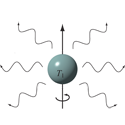Friction in a vacuum
In the Casimir effect, vacuum fluctuations of the electromagnetic field exert a force on closely spaced metal plates, a phenomenon that is well understood theoretically and detectable experimentally. Can a related effect occur for rotating systems, in which vacuum fluctuations alter the spin rate of a particle, resulting in rotational drag? Writing in Physical Review A, Alejandro Manjavacas and Javier García de Abajo of the Instituto de Óptica, Madrid, Spain, show theoretically that this should be an experimentally observable effect.
The phenomenon of vacuum friction for spinning objects is somewhat different than for the static parallel plates: the accelerating charges in a spinning conductive object interact with the vacuum fluctuations and can emit photons. Earlier work by Manjavacas and García de Abajo tackled the problem with a semiclassical model that employed the fluctuation-dissipation theorem to calculate the overall energy transfer between the spinning particle and the vacuum field. In their new calculations, they take a fully quantum mechanical approach, which not only confirms the semiclassical results but extends the results to molecular systems and magnetic interactions. In addition to their intrinsic interest, the findings may be relevant to understanding the dynamical behavior of cosmic nanoparticles such as interstellar dust and the optical spectra of rotating molecules. – David Voss





